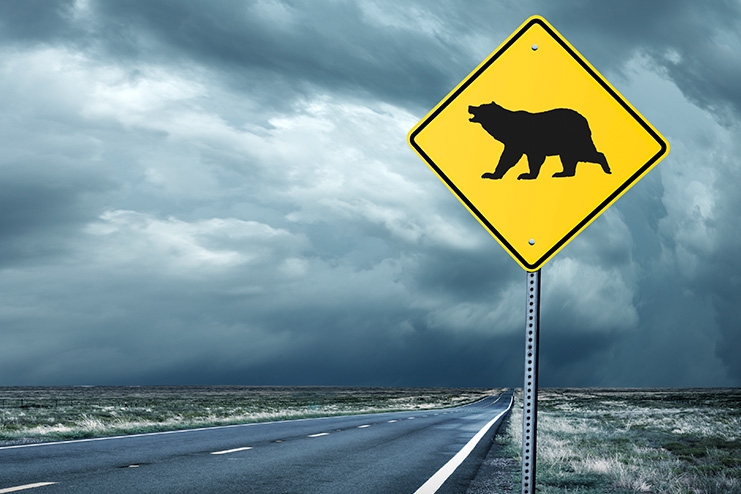How Long Does a Bear Market Last? Remember These 3 Things
The coronavirus collapse of 2020 sent the broad stock market first into correction and then into a growling bear market at a pace few could remember and even fewer predicted. Markets hate uncertainty, and in the face of an unfolding government-mandated shutdown of large sectors of the private economy, investors struggled to price companies in many industries that were on hiatus.
With little to go on, investors “catastrophized,” working up a worst-case scenario and then believing that it was highly likely. First Trust Chief Economist Brian Wesbury noted that as of March 17, 2020, the stock market was predicting a collapse of 50–80 percent in corporate earnings. To put this in perspective, corporate earnings dropped 48 percent in the debt-induced financial crisis of 2008.
No one can predict the future — ever. However, we do know the reality of the present. For diversified investors in March 2020, that meant a portfolio that was significantly lower than just two months before. In reviewing the damage with clients, I more than once stared into pained eyes and was told that it took a decade for their investments to regain losses after the 2008 crisis and that, as a person in their 60s, they didn’t have a decade this time.
I knew then this was wrong. It didn’t take a decade after 2008. I also knew that the vast majority of people have an investing horizon far longer than one decade. But perception is often one’s reality, so I set to work to put some facts to emotions. I want to share those facts with you here, in the hope that they’ll help you the next time the markets inevitably collapse.
Keep your financial plan on track during bear markets
#1: You have longer than you think
The first thing to note is that a person in their seventh or even eighth decade still has a substantial investing horizon. In my practice, I see few people slowing down in either activity or spending in their 70s. Broad data shows the average life expectancy of retirees is in the late 80s. Add to this the fact that our money is going to outlive most of us.
I still have an investment portfolio created by my great-grandpa, and he stopped being an active investor at least 45 years ago when he died. Your real-time horizon is unknown but likely decades.
Finally, I note that you won’t spend all your money at once. Rather, you’ll withdraw it in 3–6 percent increments.
This is why we create financial plans and have pockets of safety (e.g., bonds, stable value, and cash) in portfolios, substantial sums that are expected to increase in value at precisely the time when broad stock markets plummet into a bear market. You must prepare to survive the bad times so you can thrive in the good times.
Track all your investments in one place with Quicken
#2: Bear markets recover quicker than you recall
What about the common belief that it took a decade to recover from the last bear market in 2008? In March 2020, I wanted to dig into the data to test this against real portfolio returns. One fantastic thing about financial markets in the information age is that all the price data is documented and can be retrieved.
So, to see how long it took to recover from losses after the 2008 collapse, I went to my Morningstar software and created both all-stock and balanced portfolios using real index funds with an added 1 percent advisory fee. I started with the 2008 crash, for which the prior peak of the market was October 2007. From top to bottom, the market dropped 57 percent.
Ten thousand dollars invested in October 2007 in an S&P index fund (of stocks) with a 1 percent advisory fee would have fallen to just under $6,000 at the end of 2008 and surpassed $10,000 again by December 2012. In other words, a five-year round trip, including five years from top through bottom to even and four years from bottom to even.
Running the same exercise for a balanced portfolio with 40 percent bonds and 60 percent stocks showed a quicker recovery. The $10,000 in October 2007 was fully intact by the end of 2010, a three-year journey from top to recovery and two years from the nadir to the starting point. Top to bottom back to top was three years, not 10.
Run your own portfolio hypotheticals in Quicken
Every bear market is different
Of course, every crisis is different. The past does not predict the future, and although these are real investment opportunities, they do not represent any person’s actual experience. Still, it’s useful to look at one more.
For the last test, I went way back to the late 1960s. Index funds didn’t exist then, but balanced funds did, so I modeled a fund that had been in existence since 1929.
This period experienced two large dips: a 36 percent drawdown from November 1968 through May 1970 and a nearly 50 percent plunge from January 1973 through October 1974, during the so-called energy crisis and rapid inflation. For those who can remember, these were not good times.
So how did the balanced investment perform? An investment at the top in 1968 would have fully recovered by the end of 1971. An investment at the top in 1973 was whole again as we wrapped up our bicentennial celebrations at the end of 1976. At the end of February 2021, that $10,000 investment made in 1973 would be worth just under $1 million.
#3: Everything’s gonna be alright
In 2019, I wrote that every economic crisis arrives with its own accent, unique triggering events, and underlying causes. Each must follow its own path from catastrophe to recovery.
A novel virus and a vigorous government reaction to contain its health effects had triggered the latest route. In March 2020, no one had any way of knowing the exact course of the virus, the financial markets, and the real economy that would follow.
At the time, I said, “If we are to have a recession, let’s hope it’s limited in scope and pain. For those viciously attacked by this virus, let’s clear the way for our doctors, nurses, and other healthcare professionals to vigorously treat and compassionately care for them. For our portfolios, which arrive in third place after the first two concerns, if history is a guide, they will be restored to health in a far shorter time than we may expect.”
Bear or bull — it’s all temporary
That’s exactly what happened in this instance. Thankfully, the recession was brief. Our healthcare system rallied, and the pharmaceutical industry produced effective vaccines in record time. Meanwhile, financial markets did what few expected. The S&P bottomed out at the end of March and was back to reaching highs four months later.
The COVID-19 experience is certainly unprecedented, but then, crises always are. Thankfully, we are working through it as we’ve always done.
My hope, then, is that you will remember these points and this experience when the next financial crisis arrives — as it inevitably will — and your investments temporarily collapse.
Quicken has made the material on this blog available for informational purposes only. Use of this website constitutes agreement to our Terms of Use and Privacy Policy. Quicken does not offer advisory or brokerage services, does not recommend the purchase or sale of any particular securities or other investments, and does not offer tax advice. For any such advice, please consult a professional.
About the Author
Michael Lynch
Michael Lynch is the author of the best-selling book, It’s All About the Income. He is also a Certified Financial Planner with nearly twenty years of experience working with American families to craft plans that fund their dreams, educate their children, and finance their retirement.
A former onsite financial planner at ESPN, Michael has contributed to The Wall Street Journal, TheStreet’s Retirement Daily, and Investor’s Business Daily, as well as hosting Smart Money Radio for a decade. He is a regular speaker and financial planning instructor for conferences and corporations alike, including Madison Square Garden, among many others.
Michael is a four-time recipient of Financial Planner of the Year for MetLife (2008, 2009, 2010, 2016) and a 2019 inductee to the Barnum Financial Group Hall of Fame. You can enjoy his latest articles and videos at www.simpleandbig.com.
Asset allocation does not guarantee a profit or protect against loss in declining markets. There is no guarantee that a diversified portfolio will outperform a non-diversified portfolio or that diversification among asset classes will reduce risk.
Securities and investment advisory services offered through qualified registered representatives of MML Investors Services, LLC. Member SIPC. 6 Corporate Drive, Shelton, CT 06484, Tel: 203-513-6000. Any discussion of taxes is for general informational purposes only, does not purport to complete or cover every situation, and should not be construed as legal, tax or accounting advice. Clients should confer with their qualified legal, tax and accounting advisors as appropriate CRN202505-2424028



